-
11 January 1944,
-
US P-38 Lightning and P-47 Thunderbolt long-range fighters flying over Germany are joined for the first time by the P-51 Mustang.
-
12 January 1944,
-
First Allied attacks on Monte Cassino.
The battle raged from 12 January till 18 May with heavy Allied losses.
Allied Forces resume attacks at the run aground Italian front.
Cassino formed the focal point of the Gustav Line, the strongest German defences south of Rome. A natural fortress consisting of
a town on the slopes of a high mountain crowned by Benedictine Monastery and skirted to the south by three rivers, Cassino had to
be captured by the Allies in order to gain access to the Liri Valley, the so-called 'gateway to Rome.' The battle raged from
17 January until 18 May, often in appalling wet and cold weather with heavy Allied losses. Eventually, the Germans evacuated the town,
and the monastery was finally stormed by Polish troops.
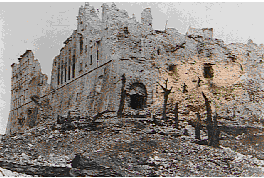
-
15 January 1944,
-
British bombers drop 2.800 tons of bombs on Berlin, Germany.

-
21 January 1944,
-
The first of Hitler's raids, 270 German aircraft, on London and southern England. The mission is a failure;
96 aircraft reach targets. Thereby, about 700 RAF bombers have made raids on Berlin, Kiel and Magdeburg.
-
22 January 1944,
-
American and British forces land at Anzio and Nettuno, Italy.
-
26 January 1944,
-
Pro-Axis Argentina, under the rule of President Juan
Domingo Peron, breaks off diplomatic relations with Germany and
Japan.
-
27 January 1944,
-
After Siege of 2½ years, Russian troops relieve Leningrad.
Railway Moskow- Leningrad is free.
| Tank and self-propelled artillery production (including German assault
guns) | | | | |
| Country | 1940 | 1941 | 1942 | 1943 |
1944 |
| UK | 1.399 | 4.841 | 8.611 | 7.476 | 4.600 |
| USSR | 2.794 | 6.590 | 24.446 | 24.089 | 28.963 |
| USA | 331 | 4.052 | 34.000 | 42.497 | 20.565 |
| Germany | 2.200 | 5.200 | 9.300 | 19.800 | 27.300 |
American and Russian produced successful medium tanks, the Sherman and T-34, but only
the Russian produced heavy tanks which could successfully confront the German Mark V (the "Panther) and Mark VI (the
"Tiger"). The Italians and Japanese made few tanks, only about 3.500 each during the war. | | |
| |
-
29 January 1944,
-
(till 6 Februari).
Several raids of the USA Fleet with carriers
(Task Force 58) at the Marshall Islands.
-
2 Februari 1944,
-
U.S. Army and Marines capture Rio, Namur and Kwajalein, the Marshall
Islands.
Soviet forces enter Estonia and Latvia.
-
4 Februari 1944,
-
Admiral Chester Nimitz becomes the military governor of
the Marshal Islands.
From 1943 Americans submarine is good organize, their best ships are from
"Gato-Class": 1500 ton, upwaterspeed 35km, radius of action 18.000km,
80 men, a good armament and superior radar. Japanese lost 5 million tonnage.
-
7 Februari 1944,
-
During the Dnjepr battle, 75.000 Germans killed from
Armygroup Oekraïne (10 Divisions).
-
17 Februari 1944,
-
Two American divisions land on the island Eniwetok.
-
21 Februari 1944,
-
Hideki Tojo is named chief of the Japanese Army
General Staff and becomes the military dictator of Japan.
-
29 Februari 1944,
-
The Southwest Pacific-Forces of the USA begin with invasion of
the Admirality-islands and the Bismarck-archipelago.
-
6 March 1944,
-
American B-24 of the US Eighth Army Air Force bombers drop 2.000 tons of bombs on Berlin, Germany.
It was their first large-scale daylight raids on Berlin. They lose 1 in 10 of their aircraft, but their
escorting fighters get the better of the Luftwaffe.
Third Ukranian Front joins the Sovjet offensive and von Kleist's Army Group A feels the pressure of this push.
-
8 March 1944,
-
Battle of Imphal and Kohima begins.
In northern Burma the Japanese begin their moves against
the British forces in the areas around Imphal and Kohima. Operation 'U-Go' aims to destroy these units,
push on through to Dimapur, cut off the Chinese and US forces, and open a route into India.
The well-organised and supplied British IV Corps meets the first Japanese attacks; they know what
the Japanese are planning, but are surprised by the scale of the Japanese commitment.
In the Pacific a regrouped and enlarged Japanese force prepares to attack the US bridgehead in Bougainville;
the US aircraft have to be flown to safety elsewhere.
-
8 March 1944,
-
US Eighth Army Air Force sends some 1.800 bombers escorted by 1.100
fighters on raids to Berlin. In desperation the Germans resort to the
deployment of training aircraft in their endeavours to counter this armada.
-
10 March 1944,
-
In Burma the scale and pace of Japanese 33rd Division's advance causes alarm as l7th Indian Division's positions are threatened. At Witok further Japanese moves are contained, and Chindit operations
farther south see Japanese communication lines hit.
-
12 March 1944,
-
In Burma Allied air support have dropped more than 9.000 men plus animals and equipment into the "Broadway"
stronghold (200/150 miles behind the main Japanese front in Assam) in about 6 nights. That means Spitfires are now operating from the airstrip at "Broadway"
and other flights continue to complement the resourcefullnes of the ground troops;
the first helicopters in the history of warfare are used to evacuate wounded soldiers.
The first helicopters were bought by the American Army in 1941, but used little in the war.
-
12 March 1944,
-
The British Government suspends all travel between
Ireland and Great Britain.
-
19 March 1944,
-
4 O'clock: Operation "Margarethe": German occupation of
strategical important points in Hungary (Minister-President Sztójay).
-
22 March 1944,
-
Japanese forces invade India.
-
24 March 1944,
-
The leader of the Chindits General Orde Wingate is killed in a air crash in the Bishanpur mountains.
Without his determined voice this unique section of the British Army in Burma will not enjoy
the same recognition or dynamic deployment.
-
25 March 1944,
-
Allied Airmens escape in Air Force Prisoner of War
camps run by the Luftwaffe, called Stalag Luft, short for Stammlager
or Permanent Camps for Airmen.
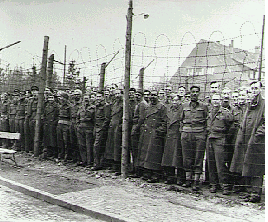
British officers liberated from Oflag 17 in Brunswick in Germany.
-
30 March 1944,
-
Raid on Nuremberg : The Royal Air Force suffers its worst losses of the war in a raid on Nuremberg.
A combination of bad planning, no diversionary raids, weather different from what had been predicted
so than the 250-mile penultimate leg of the journey is flown in a dead straight line in clear sky result
in 96 aircraft being shot down by the night-fighters from a total of 795. Cloud over the city meant
that only a small proportion of the force hit the target with 2.500 tons of bombs.
-
2 April 1944,
-
The first B-29 Superfortress reaches India after a flight from the USA via the UK and North Africa.
This heavy bomber will enter the war against Japan.
In Burma, the Japanese cut the Kohima road, while l7th Indian Division continues its troublesome withdrawal to Imphal.
On the Eastern Front, Sovjet forces entered Roumania, by crossing the river Prut.
-
3 April 1944,
-
Operation "Tungsten":
42 bombers and 80 fighters from the carriers Furious and HMS Victorious bombed the Tirpitz and caused sufficient damage with 15 hits to extend the vessel's inactivity by another 3 months. By the attack 122 men of the crew were killed and 316 wounded. The Tirpitz was finally destroyed in November 1944 by heavy bombers from 617 Squadron RAF.
-
5 April 1944,
-
General Charles de Gaulle becomes head of the French
Provisional Government in London, England.
Begin of American systematic bombardements on Romania oil-fields
from South-Italy.
-
12 April 1944,
-
A massive air-battle takes place over Germany. More than
2.000 American aircraft are involved.
-
18 April 1944,
-
Allied air force launch a 30-hour air offensive on France and
Germany.
-
22 April ,
-
U.S. Army land at Hollandia, Netherlands New Guinea.
-
25 April 1944,
-
Japanese forces launch a major offensive against Honan
Province, China.

Chinese troops and dead Japanese soldiers killed in the Allied offensive in the Pacific.
-
5 May 1944,
-
Indian Nationalist Gandhi is released from detention in India.
Admiral Koga, Commander of the Japanese Fleet, is killed.
-
9 May 1944,
-
Soviet forces recapture Sevastopol.
-
18 May 1944,
-
Polish troops hoist their red-white flag on the ruins
of Monte Cassino.
In 24 days hard fighting, impregnable Cassino fell, two German armies were defeated, 20,000 prisoners were taken,
three defence lined were smashed, and vast quantities of German material were destroyed. But Allied casualties in the four
battles amounted to about 21,000 including 4,100 killed in action.
The historic Benedictine monastery at Cassino, Italy, which the Germans used as an observation post and artillery position, now stands demolished. The abbey fell to Allied troops after fierce and bitter fighting.
German troops evacuate Monti Cassino, Italy.
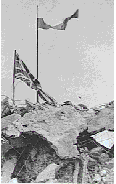
-
22 May 1944,
-
Referendum in Iceland calls for the complete separation from
Denmark.
-
23 May 1944,
-
Allied forces begin an offensive from the beaches of Anzio,
Italy.
-
25 May 1944,
-
The Raid on Drvar: also codenamed Operation Rösselsprung took place from 25 May 1944 to 3 July 1944,
Marshal Josip Broz Tito and British Major Randolph
Churchill narrowly escape an invasion by a German paratrooper force
dropped on Tito's headquarters at Drvar, in Bosnia.
-
27 May 1944,
-
The Americans land on Biak Island, New Guinea, in the Pacific, after bombarding Japanese positions there. There is a substantial Japanese garrison but the landing passes without much opposition; this will come when the Americans seek to move inland to their strategic targets.
Battle of Biak
The Battle of Biak was a hard-fought Allied campaign during May and June 1944 to recapture the
island of Biak, off the north coast of New Guinea, from the Japanese who were using it as an air base.
American and Australian troops attacked the island on the 27 May 1944.
The Japanese garrison put up strong resistance and the island was not secured
until the 29 June, with 2.700 Allied casualties and 9.000 Japanese.
On 1 june 1944 the Americans are deploying tanks against the Japanese on Biak
-
1 June 1944,
-
The first coded message announcing the D-Day landings is broadcast to the French resistance by the BBC in the form of poetry.
The Germans track the information given and alert some of their units in northern France.
The German Army's military intelligence unit, the Abwehr, is removed from the control of the Wehrmacht by Hitler. Its chief, Admiral Canaris, is dismissed and all secret service activities are placed in the hands of Heinrich Himmler, the SS leader.
Canaris has been clandestinely conspiring against Hitler.
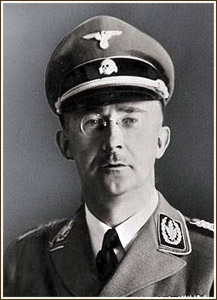
Heinrich Himmler, the SS leader.
-
4 June 1944,
-
19.15u: 88th American division march into Rome.
Allied forces recapture Rome, Italy.
Build-up of supplies before D-Day:
From 1942 onwards many people believed and hoped that the opening of a 'second front' on the continent would soon be possible.
But it was not until the end of 1943 that serious preparations for the re-invasion of Europe across the Channel began. In the south of England seemingly endless convoys of military vehicles and troops of all the Allied nations poured along the roads and railways of Britain towards the sealed coastal area.
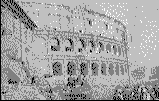
-
4 June 1944,
-
The second half of the coded signal is broadcast to the french resistance and again the Germans note it but fail to react correctly;
even the 7th Army in Normandy is not told of it. In the middle of the night airborne troops fly from airfields in southern England; the
convoy transporting the ground troops is already at sea. Allied bombers wreck 10 of the most important coastal fortifications between
Cherbourg and Le Harve.
-
6 June 1944,
-
Allied forces launch the D-Day invasion of Normandy, France.
Preparations for the invasion of Europe by the Allies involved enormous movements of men and equipment and considerable
secrecy in order to conceal the exact timing and destination from the Germans. The men did not know until the last possible
moment where and when they were going.
From 1942 onwards many people believed and hoped that the opening of a 'second front' on the continent would soon be possible.
But it was not until the end of 1943 that serious preparations for the re-invasion of Europe across the Channel began.
In the south of England seemingly endless convoys of military vehicles and troops of all the Allied nations poured along the roads
and railways of Britain towards the sealed coastal area.


|
Sherman M4: Like the M4 Sherman tank, the main role of the M4a1 tank was to
assist infantry in breaking through enemy's defenses and then rapidly penetrate
far behind enemy lines and disrupt supplies and communications.
The M4a1 carried 6 fewer rounds and ammunition then the Sherman I.
The Sherman's 75mm gun could take on the Pz-IV, but not Panthers or Tigers.
|
Relative strength at the begin of the Allied Invasion
in the Normandy. | | | |
| Germany
------- | Allied
------ | |
| Infantry div. | 49 | 6 | |
| Motorized div. | -- | 25 | From that 40 div. in the first wave |
| Tank div. | 10 | 55 | |
| Tanks | 1600 | (?) | |
| Bombers | 198 | 3467 | |
| Fighters | 125 | 5409 | |
| Tran./other planes | 115 | -- | |
| Gliders | -- | 4900 | |
| Battleships | -- | 7 | |
| Cruisers | - | 27 | |
| Destroyers | 3 | 164 | |
| Motor-torpedoboat | 36 | -- | |
| Submarines | 34 | -- | |
| Landing-crafts | -- | 5000 | all kinds of |
| Total strength of the Allied at 8 June 1944: 2.700.000 men.
In Octobre: 3.050.000 men, of which 800.000 men in England. | | | |
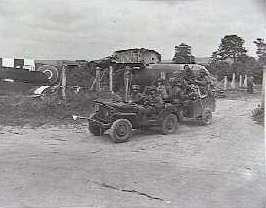
Glider troops, having unloaded jeeps, trailers
and equipment from gliders press on inland.
Normandy landings.
-
6 June 1944,
-
Normandy landings.
The cross-Channel invasion ofEurope, D-Day, 6June 1944. Since 1942 the German High Command had expected an Allied attack on what Nazi
propaganda had named Festung Europa (Fortress Europe). After the Dieppe raid had been successfully repulsed, German fortifications along
the French coast were extended and deepened, until by 1944 they presented a formidable barrier. to any landing force. Behind the barrier,
which Hitler called the Atlantic Wall, stood fifty-nine divisions, ten of which were Panzer divisions capable of mounting a swift counter
-attack on any Allied beachhead that might be established.
Field Marshal von Rundstedt, the commander in the west, thought the Calais area the most likely choice for an Allied landing. Hitler,
however, had come to the conclusion that Normandy would be the most-favoured coastal area, with the large port of Cherbourg as the main
Allied target. Rommel. who was by now the tactical commander of the coastal areas, inclined to Hitler's view.
Between von Rundstedt and Rommel there was a further difference of professional opinion as to how the Allied attack should be repulsed.
Rundstedt preferred a carefully planned counter-attack after the Allied landings had been consolidated; Rommel believed the Germans would
have to win the battle on the beaches in the confusion of the first hours of the landing. Once the beachheads had been consolidated, he
considered it certain that Allied air power would be able to defend the Allied gains from the prepared German counter-attack of the type
in which von Rundstedt placed his faith.
Whatever their view as to the most appropte tactics to be employed against the landings, neither of the commanders nor the troops under
them were prepared for the vast armada which appeared off the coast of Normandy 0m the morning of 6 June 1944: there were S9 convoys, at
American and 38 British, over 2.000 transport ships escorted by 700 warships, including 23 cruisers and 5 battleships. In fact, American
and British airborne units had already seized the flanks as the seaborne troops in the landing craft approached the beaches: Utah and the
fateful Omaha for the Americans; Gold, Juno and Sword for the British and Canadians.
Communications in the German command chain were a compound of bungling and disbelief. Rommel, the proponent of an immediate counter-attack
while the enemy were still on the beaches, was back in Germany celebrating
wife's birthday; he was not informed until after 10.00 a.m. that the Allies had landed; thus, what he had characterized as `the longest
day' was almost half over before the German tactical commander could intervene.
By midday, 5 Allied divisions (2 US, 2 British and 1 Canadian) were safely ashore. Only at the US Omaha beach landing had the attackers
suffered the violent response for which they had trained in innumerable manoeuvres.
By nightfall of the longest day the Allies had nowhere quite achieved the depth of penetration planned; but they had succeeded in landing
the colossal number of 155.000 fully equipped soldiers on the continent of Europe. Deception techniques made Hitler retain formations in
the Calais area in expectation of the `main attack' still to come. Perhaps only Rommel - who believed that die result of that first day
would determine the outcome of the campaign, and even of the war - realized that although no major battles had been fought, the German
forces had nevertheless lost the day.
(till 2 July). The Allied Sea-Operation "Neptune":

| 6 June: | Meer 5.000 ships and landings-crafts carried 5 Allied
divisions to the French coast.At the first 48 hours, 107.000 men landed. |
| 12 June: | In total 326.000 men, 104.000 ton material and 54.000 vehicles
were carried to the french coast |
| 17 June: | 587.000 landed |
| 2 July: | In total 929.000 men, 586.000 ton material and 177.000 vehicles
landed |
| 15 August: | About 2.000.000 men landed |
-
9 June 1944,
-
Begin of the Russian offensive from the "Karelish landengte" against
the Finnish Army (Marshal Mannerheim).
Prime Minister of Italy Marshal Badoglio is forced to resign and replaced by Ivanoe Bonomi,
a opponent of the Fascist movement.
-
10 June 1944,
-
Destruction of the French village Oradour-sur-Glane by the Waffen-SS;
all 642 villager are killed.
Oradour-sur-Glane
Village in France (north-west of Limoges) where the SS 2nd Panzer Division, Das Reich, murdered some 600 inhabitants during the aftemoon of 10 June, 1944. The division, which was on in way from its assembly area around Montauban to the new invasion front in Normandy, had already committed a number of atrocities (most notably the hanging of 89 men in Tulle) on its way north. A degree of mystery still surrounds the motives for the Oradour massacre. Certainly the division had been severely harried by resistance fighters as it travelled through the Lot and Correze, but the suggestion remains unproven that the headquarten company had lost the diviaional war chest in an ambush outside Oradour and believed members of the village to be responsible.
-
13 June 1944,
-
V-1 named "Vergeltungswaffe".
Germany launches its first V-1 rocket attack on England, till 20 June
8000 V-1's fired to London.
The first salvo of 10 V1 flying bombs is launched at the UK from the Pas-de-Calais,
but only 4 make it across the English Channel. One hits the village of Swanscombe,
20 miles from its London target, another lands in the Sussex town of Cuckfield and the third
reaches the London suburb of Bethnal Green, killing 6 people.
The German spotter plane sent to report on the raid is shot down.

V-1 (Vergeltungswaffe 1-Reprisal weapon 1)
A fast pilotless flying bomb carrying one-ton warhead. Psychologically one of the war's most effectieve weapons,
the V-1 buzzed (thus to Londoners becoming the 'buzz-bomb') like a angry hornet, the engine cutting out dramatically
over the target.
Thereafter those on the ground waited for the contact explosion of the warhead. In the summer of 1944, more than 8.000
V-1's exploded on London. Many were shot down over Kent and some were even "returned" by the RAF fighters
nudging their wingtips to redirect them back across the Channel. Although the weapon failed in its attempt to
destroy British morale, it was nevertheless responsible for over 5.000 killed, 40.000 wounded and 75.000 houses
damaged or destroyed.
-
14 June 1944,
-
General de Gaulle returns to France.
U.S B-29 Superfortress bomber make their first raid on Japan from bases in China.
-
15 June 1944,
-
American landing on Saipan (Marianen).
Russia force Finland till the "Mannerheim linie".
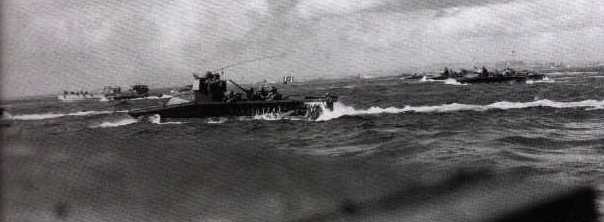
Saipan landings from an assault craft.
-
17 June 1944,
-
Allies invade Elba. Iceland is declared a republic.
-
19 June 1944,
-
The Sea-Air Battle of the Philippine Sea.
Between the Japanese Fleet with 9 Aircraft carriers and the American
Navy-Air Force And the Task Force 58 with 15 Aircraft Carriers. The Japanese
lost by Submarines and Planes; 3 Carriers and more then 400 Planes ("The Marianes'
Turkey Shoot").
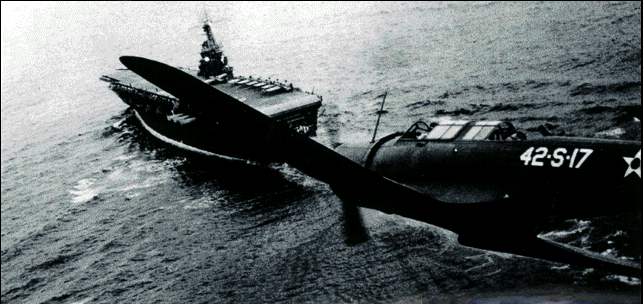
The US carrier Ranger did participate in transporting fighters to
Malta, Operation Torch (invasion of N. Africa), and Operation Tungsten
(attack on the Tirpitz) while operating in the Atlantic.
The plane is a Vought Vindicater reconnaissance and dive bomber (photo at the beginning of WW II) ... the side numbers 42-S-17
clearly identify it as one of Ranger's. Ranger has Air Group 4,
consisting of VF-41, VS-41, and VS-42.
-
21 June 1944,
-
Allied offensive in Burma.
-
22 June 1944,
-
Operation Bagration.The Sovjet Army under Stalin began offensive Bagration into Poland; in 6 weeks advanced 500 km to the Vistula.
Three years to the day after Germany's 1941 invasion of the Soviet Union, the Red Army launched a massive
offensive in Byelorussia. Codenamed 'Operation Bagration', this campaign climaxed five weeks later with
the Red Army at the gates of Warsaw. The Wehrmacht's Army Group Centre was routed, a total of 17 Wehrmacht
divisions were utterly destroyed, and over 50 other German divisions were shattered. It was the most
calamitous defeat of the German armed forces in World War II.
-
30 June 1944,
-
The U.S. Fourteenth Air Force abandons its air base at
Hengyang, Hunan Province, China.
-
July 1944,
-
Operation Valkyrie
German plan to mobilize reserve army units and to seize control after the planned assassination of Adolph Hitler, in July 1944.
The plan failed and its leaders, including Count von Stauffenberg, were executed.
Valkyrie (Operation Valkyrie). A contingency plan, devised by anti-Nazi conspirator von Stauffenberg, for Berlin garrison troops to seize key points in the capital in the event of a revolt by the thousands of slave and foreign workers billeted in and around the city. The importance of Valkyrie is that it was in fact a brilliantly devised cover-story whose real purpose was to organize the seizure of Berlin once the conspirators' first object, the assassination of Hitler, had been achieved.
-
July 1944,
-
In the first days of July, 1944, the first Echelon of the Brazilian Expeditionary Force (FEB) left to Europe, aboard the American ship General Mann, in a total of 5.081 men. Later, on the 22 July, two more ships, Gen Mann and Gen Meigs, left to Europe, with the Second and Third Echelons, with 10.369 men total.
-
3 July 1944,
-
Soviet forces recapture Minsk.
-
9 July ,
-
U.S. Army and Marines capture Saipan, the Marianas.
Nearly the whole Japanese Army of occupation fall,
about 3.000 Japanese wounded commit suicide; too
Admiral Nagoemo commit hara-kiri. The Japanese have lost about 27.000 men,
the American more than 3.000 men and 4 times more injured.
-
12 July 1944,
-
Theodore Roosevelt jr. fall in the Normandy.
-
13 July 1944,
-
The Battle of Guam was a US operation to recapture the island of Guam from the Japanese in 1943, during WW II.
Guam is at the southern end of the Marianas group, about 1.600 km north of New Guinea.
It was occupied by the Japanese on 10 December 1941 and used as a naval and air base. US forces invaded on 21 July 1943 and by 10 August the entire island was in their hands. US losses amounted to 1.744 killed and 5.970 wounded; the Japanese lost 18.250 killed and 1.250 captured. Some of the Japanese garrison fled to the interior of the island,
the last of them did not surrender until 1960.
-
18 July 1944,
-
British forces break-out at Caen, France.
-
18 July 1944,
-
Japanese General Hideki Tojo is relieved as Chief of the
General Staff. He is replaced by General Yoshijiro Umezu (General Koiso
and General Yonai).
Day raids on Peenemunde, night on Ruhr.
-
19 July 1944,
-
The entire Government of Japan resigns, Emperor Hirohito
asks General Kuniaka Koiso to form a new government.
-
20 July 1944,
-
Adolf Hitler is wounded in an murder attempt at his
headquarters "Wolfschanze" in Rastenburg, East Prussia.
Failed attempt by German conservatives to
overthrow the Nazi government and kill
Hitler (who survives the bomb blast relatively unhurt).
Operation Valkyrie
German plan to mobilize reserve army units and to seize control after the planned assassination of Adolph Hitler, in July 1944. The plan failed and its leaders, including Count von Stauffenberg, were executed.
Valkyrie (Operation Valkyrie). A contingency plan, devised by anti-Nazi conspirator von Stauffenberg, for Berlin garrison troops to seize key points in the capital in the event of a revolt by the thousands of slave and foreign workers billeted in and around the city. The importance of Valkyrie is that it was in fact a brilliantly devised cover-story whose real purpose was to organize the seizure of Berlin once the conspirators' first object, the assassination of Hitler, had been achieved.
-
21 July 1944,
-
U.S. Army and Marines invade Guam.
The Battle of Guam was a US operation to recapture the island of Guam from the Japanese in 1943, during World War II. Guam is at the southern end of the Marianas group, about 1.600 km north of New Guinea. It was occupied by the Japanese on the 10 December 1941 and used as a naval and air base. US forces invaded on the 21 July 1944 and by the 10 August the entire island was in their hands.
Facing them are nearly 20.000 Japanese but the landings are almost unopposed and eventually 55.000 US troops will go on land.
US losses amounted to 1.744 killed and 5.970 wounded; the Japanese lost 18.250 killed and 1.250 captured.
Some of the Japanese garrison fled to the interior of the island, the last of
them did not surrender until 1960.
-
24 July 1944,
-
Majdanek, the first great Concentration Camp at liberty by 1st Ukraine Front.
Lublin also known as Majdanek. Lublin was fitted with gas chambers in the autumn of 1942. By the end 200.000
people had been murdered there.
US forces land on Tinian and face Japanese troops, 6.000 men. Early skirmishes are seen off
but with considerable losses. Napalm is used for the first time in the Pacific theatre.
-
25 July 1944,
-
U.S. forces (1th and 3th Army) break-out at Sainte-Lo, France, support
with 1500 heavy bombers.
Operation "Cobra": The Americans force break-through at Avranches.
-
27 July ,
-
Reichsmarshal Hermann Goering is named as Germany's
Mobilization Director, "to adapt in every respect the entire public life to
the necessities of total warfare."
Josef Goebels is named; "Reichskommissar für den totalen Kriegseinsatz".
-
1 August 1944,
-
(till 2 October).The Warsaw Resistance Army (General Count Bor-Komorowski), also named Polish Home Army,
begins battling German forces in Poland.
The Poles in Warsaw rose up against the Nazis at the end of the war knowing that the Red Army was only a few miles away.
The Russians however left the Poles to fight alone.
The revolt lasted two months before the Poles ran out of food and ammunition.
Tinian liberated; In the Pacific fighting ended on Tinian (Marianas): Japan lost more than 6.000 men,
the American just 390 men.
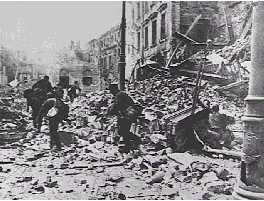
-
2 August 1944,
-
Soviet forces reach the Baltic Sea west of Riga, Latvia.
Ryti, the President of Finland resigns, he is replaced by Marshal Carl
von Mannerheim.
-
2 August 1944,
-
Sowjet Unions recognition of "Comité of Lublin", Polen.
Churchill declares: 4.735 men killed by V1's; more then 14.000 wounded;
17.000 houses destroyed and 800.000 damaged.
-
3 August 1944,
-
In Burma the siege of Myitkyina ends when the town is taken by Chinese and Americans,
they found most of the Japanese army has escaped.
-
7+8 August 1944,
-
"Das Volksgerichtshof" in Berlin (led by Freisler) against the
men from 20 July.
-
9 August 1944,
-
General Eisenhower moves his command headquarters from
England to Normandy, France.
-
10 August 1944,
-
U.S. Army and Marines capture Guam.
-
11 August,
-
German forces evacuate Florence, Italy.
-
15 August 1944,
-
Operation "Dragoon": Allied forces, the 7th American Army
(3 American and 7 French divisions) invade southern France, east of Toulon.
The Allied landing in the South of France started when troops from General Patch's US 7th Army and
French Commandos (II French Corps) came ashore between Cannes and Toulon. Naval bombardment supports
the beachheads and carrier aircraft outnumber the Luftwaffe 25:1. The action is followed by Winston Churchill
from distance and he saw little German opposition to the attack; General Weise has only 7 infantry divisions
and 11th Panzer Division to protect the entire south and south-east of France.
-
16 August 1944,
-
"The sack of Falaise": About 250.000 Germans of the 5th and 7th Army
enclosed near Falaise.
-
20 August 1944,
-
Marshal Pétain placed in arrest by the Germans and brought to the Castle
Sigmaringen.
-
21 August 1944,
-
(till 9 Octobre). Conference of Dumbarton Oaks, between USA, Great-Britain,
Sowjet-Union and China.
Allied representatives meet at Dumbarton Oaks, near Washington, D.C., in a
conference to discuss postwar security. An agreement is signed to
create an assembly of all nations, a council of leading states, and an
International Court of Justice. Among those attending are Edward
Stettinius (U.S.), Sir Alexander Cadogan (British) and Andrei Gromyko
(Soviet Union). This assembly is to be known as the United Nations.
-
23 August 1944,
-
Pro-Axis leader of Romania Marshal Ion Antonescu is
arrested and replaced by Sanatescu. After the war, Antonescu is tried
and executed. Romania declares war on German and joins the Allied
battle.
-
24 August 1944,
-
Allied forces capture Bordeaux, France.
Britain attack on the Tirpitz in the Altafjord.
-
25 August 1944,
-
Liberation of Paris by Free French, US, and British
forces. General Jacques LeClerc accepts the German
surrender (General von Cholitz).
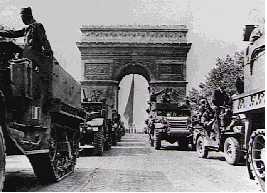
Armoured vehicles of the Free French leading the victory parade under the Arc de Triomphe
-
26 August 1944,
-
The Great Liberation Parade, Paris, France.
Hitler's order: evacute Greece by Armygroup E, General Löhr.
-
30 August 1944,
-
The Soviet occupation of Ploesti denies the Roumanian oilfields to the Germans whos supplies have already
been severly reduced by Allied bombing.
-
31 August 1944,
-
American forces reach the old French Maginot Line.
Russian troops capture the oil-fiels of Ploesti.
-
31 August 1944,
-
(till 14 september). The U.S.- Task Force 38 (before Task Force 58)
execute raids on Iwo Jima and the Boninei islands, the West Carolinen,
the Plau- islands, Mindanano and the Visayas-archipel (the Phillippines).
|

|
The DUKW was a amphibious cargo carrier. Basically it was a ca 2½ ton
truck that was converted to be boat to carry men and equipment.The DUKW
had no armor and carried a single machine gun.Some 20.000 DUKW were built
and was used in all theaters of war. |
-
1 September 1944,
-
Soviet forces enter Bucharest, Romania.
Allied penetrate the "Gothenline" in Italy over about
30 km.
-
3 September 1944,
-
British forces, under Lieutenant General Sir Miles C.
Dempsey, capture Brussels, Belgium.
-
4 September 1944,
-
An armistice is declared between Finland and the Soviet
Union. Finnish order: Germany must leave Finland for 16 September.
-
5 September 1944,
-
The Soviet Union declares war on Bulgaria.
-
7 September 1944,
-
Hungary declares war on Romania in hope of retaining
the territory of Transylvania.
-
8 September 1944,
-
The Germans launched the first V-2 rocket and hits England (London).
Launched from Wassenaar, a suburb of The Hague still in German hands, the first V-2 rocket to land in England reaches Chiswick in west London. At this point the threat from the V-1 has been chiefly removed by the capture of the launch sites in France, but now the new projectile, fired from mobile launchers, poses a new problem. Its 192-mile flight is completed in five minutes and brings devastation to six houses in Staveley Road, much additional damage, and three people killed and ten injured. This was not the intended target, of course, but those witnessing the event cannot explain the cause of the explosion because the speed of the projectile is such that it arrives before the sound of its passage is heard. Press statements are minimal and the public remains in the dark for two months. The Allies will find it difficult to fly raids against the mobile launch vehicles even though they quickly trace the area in which they are operating. The V-2 programme will have a minimal effect on the war as a whole, the daily bombardment barely equalling the effect of a single Allied bomber over Germany.
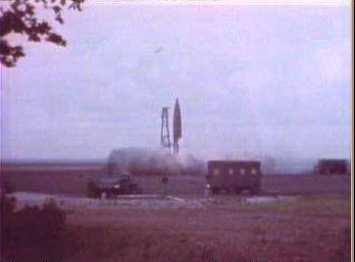
Launched a V-2 rocket.
-
9 September 1944,
-
An armistice is declared between Bulgaria and the
Soviet Union.
-
10 September 1944,
-
Roosevelt and Churchill meet in Quebec, Canada.
American troops capture Luxemburg.
-
11 September 1944,
-
Units of the 1th American Army cross German border, north of Trier.
Patrols of the 2th British Army cross Dutch border, north of Leopoldsbrug.
-
15 September 1944,
-
Armed Forces of the US in the south-west Pacific invaded Morotai and the Palau-islands,
the Japanese-held island of Peleliu (Palau) was one of the bitterest
battles of the Pacific war and did not end for 10 weeks.
-
17 September 1944,
-
Operation "Market Garden": Allied paratroops land inside the
Netherlands,
in the biggest airborne operation ever attempted.
Railway strike in the Netherlands.
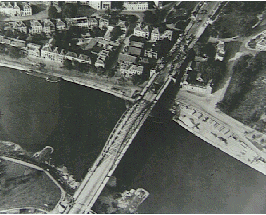
The bridge at Arnhem, vital to the success of Operation Market Garden, during the battle between the British airborne troops
(holding the north end of the bridge) and German forces (Allied invasion of Holland is also known as Airborne invasion of Holland,
Arnhem, Operation Market Garden).
-
17 September 1944,
-
The U.S. Fourteenth Air Force abandons its air base at Kweilin, China.
-
20 September 1944,
-
British Guards Armoured Division and 82th Airborne Division have taken Nimwegen
by a fast attack which too captures the important bridge over the Waal
before the Germans could destroy it. At Arnheim the paratroops unit loses
its hold on one end of the bridge.
-
24 September 1944,
-
Hitlers's order the formation of the "Volkssturm".
Soviet forces invade Czechoslovakia.
-
26 September 1944,
-
End of "Market Garden"; 2.400 soldiers come back across the river
"Rhein" from Oosterbeek, 10.000 soldiers were dropped north of the
river.
-
1 October 1944,
-
Begin of Operations for liberation of "Zeeuws-Vlaanderen", "Zuid-Beveland"
and "Walcheren".
-
2 October 1944,
-
The Warsaw Resistance Army surrenders to German forces, after
2 month heavy fight, ended in a Polnish disaster.
-
4 October 1944,
-
The Me 262 fighters, their first action are ineffective. They will
eventually shoot down 25 Allied bombers, but their cumbersome take-off
and landing, and the routing restrictions necessitated by their high fuel
consumption, sees 35 of them lost.
-
7 October 1944,
-
Heavy air raids on German oil centres, by day.
-
7-16 October 1944,
-
The battle of Aachen, the capture of Aachen, the first German city to fall (secured on 21th october),
the offensive of the American 1st and 9th Armies to the Rür, which included the battle of the Hürtgen Forest, Operation Queen, the largest
aerial close support operation of the war against the German lines east of Aachen;
A total of 2,807 planes dropped 10,097 tons of bombs.
-
9 October 1944,
-
Moscow conference. In Moscow a conference begins between the Soviets and a British delegation
led by Churchill and Anthony Eden.
The topic is the future of Eastern Europe and Stalin cleverly reminds his visitors of his readiness
to help defeat the Japanese as a means of wringing concessions from them.
While Greece is to remain under British influence and the power somewhat divided in Hungary and Yugoslavia,
the Russians insist that Bulgaria and Roumania remain under their umbrella, and refuse to yield
to demands for autonomy from the exiled Polish government.
-
14 October 1944,
-
British and Greek forces recapture Piraeus and Athens, Greece.
The death of Field Marshal Rommel from wounds suffererd in battle is announced to the German nation. The
broadcast does not disclose that the great commander has been forced to commit suicide by poison rather
than face a humiliating public trial to answer the charge of being part of the July Bomb Plot. The
Desert Fox is given a state funeral.
Rommel, Erwin (1891-1944).
The `Desert Fox'. A most popular general
in Germany who also had a good reputation among Allied soldiers. Born near Ulm, Rommel appears to have
had no other ambition than to become a professional soldier. He had distinguished himself as a battle
group leader in WW I and later wrote on new infantry tactics. Hitler was impressed by his book 'Infantry
Attacks' and from 1938 Rommel commanded Hitler's HQ staff, first in Austria then in Czechoslovakia and
Poland. After serving as a successful Panzer division commander in the invasion of France in 1940, he
was given command ofthe new Afrika Korps in 1941 and drove the British 8th Army out of Libya into Egypt.
In June 1942 he was made FieldMarshal. Shortage ofsupplies, combined with British superiority in air
cover and gradually increasing forces, checked his advance as it approached the Nile. Late in 1942 lhe
was decisively defeated at the Battle of El Alamein, and retreated westwards as Anglo-American armies
landed in Morocco and Algeria. His forces were compelled to surrender Tunisia in 1943. Escaping the
North African debacle he commanded in Italy until given Army Group Northern France to prepare for the
Allied invasion in 1944. Here, unable to check the Anglo-American invasion on D-Day in June 1944 and its
advance into France, he begged Hitler to end the war.
The army conspirators of the July 1944 Bomb Plot had hoped to have him on their side, but he had in fact
refused to involve himself in an assassination attempt; instead, he preferred to bring Hitler to trial.
It is uncertain quite how Rommel's name was connected with the conspirators, but in October 1944 he was
at home recovering from wounds received during an air-raid, when he was visited by two fellow generals
and told he was to be arrested. He chose suicide and a state funeral, rather than a trial and certain
conviction.
In 1942 Germany needed a hero; for its part, Britain needed to show that it had beaten a great general.
To praise Rommel was therefore in the interests of both sides, although he had in fact commanded only in
North Africa and briefly held a major European fighting command in 1944.
-
18 October 1944,
-
Volkssturm formed; the last-ditch defenders of the Reich. All men aged
from sixteen to sixty were organized in their districts, with few uniforms, with little
training and with any weapons that could be found, under the leadersbip of any
available officers from the SS, SA, NSKK or Hitler Youth. Units of this home defence
force varied greatly in quality. Young boys of the Hitler Youth were reputed to have
fought with great ferocity in the last days of Berlin. The Volkssturm, intended to
fight in their own areas, might have made a significant defence contribution had they
not been thrown into the last battles of the Reich whenever there was a desperate need.
-
20 October 1944,
-
U.S. landing on Leyte island in Philippines.
-
20 October 1944,
-
Soviet forces invade East Prussia.
-
20 October 1944,
-
Tito's Partisans, along with Russian forces, complete the liberation of
Belgrade. Partisans take Dubrovnik, Russians take Debrecen, Hungary.
-
23 October 1944,
-
The German newsbureau reports vast numbers of volunteers, to join the Volkssturm territorial army, including boys and men
younger and older than the specified age groups.
-
23 October 1944,
-
(till 26 October).The Battle of Leyte Gulf, was the biggest (3-day) naval battle of WW II, results in heavy Japanese
naval losses and the sinking of the U.S. aircraft carrier U.S.S. Princeton. Admiral Kinkaid's US 7th Fleet escorts the first landing-parties from General Kruegers's 6th Army to Leyte. There was little resistance from Japanese 16th Division,
the first day about 130.000 US troops came ashore.
These ships took part (losses in brackets) in
the Gulf of Leyte | |
| Ships | US Navy | Japan |
| Fleet Aircraft Carriers | 5 (1) | 1 (1) |
| Battleship-Carrier | - | 2 |
| Light Carriers | 21 (3) | 5 (3) |
| Battleships | 12 | 7 (3) |
| Heavy Cruisers | 5 | 13 (6) |
| Light Cruisers | 11 | 4 (4) |
| Destroyers | 80 (4) | 37 (12) |
| End December the battle ended.400 Japanese were
left over from 50.000 defenders; the American lost 3.000 men, 10.000 wounded. | | |
-
25 October 1944,
-
Russians invade Norway, take Kirkenes.
-
27 October 1944,
-
In Europe the Germans mount a strong counter-attack against British forces near Venlo,
winter conditions begin to play a part.
German submarine U-1060 grounded in the North Sea, after damages by rockets and depth charges.
-
29 October 1944,
-
Last gassing in Auschwitz.
-
31 October 1944,
-
RAF Bomber Command make a successful precision attack on the Gestapo HQ in Aarhus, Denmark,
destroying many of the records held there.
-
November 1944,
-
The notorious Burma railway ready for use, a dead railway
from about 400 km, some 150.000 allied prisoners of war
and southeast asian convicts died by building this railroad.
-
1 November 1944,
-
The battle of Walcheren. 3 Commando groups land with the British 52th Division and bad weather
reduces air support but battleship Warspite and some more ships provide gunfire.
Several landing-ships are lost on their approach to the garrisoned island.
A US aircraft flies a reconnaissance mission over Tokyo, this is the first flight
over the capital since the Doolittle raid of April 1942.
-
4 November 1944,
-
Whole Greece free.
-
6 November 1944,
-
Joseph Stalin renounce the neutrality pact between the
Soviet Union and Japan.
-
7 November 1944,
-
Franklin D. Roosevelt is elected to an unprecedented
fourth term as President of the United States.
-
10+11 November 1944,
-
Razzia in Rotterdam, Netherlands; 50.000 men deported.
-
12 November 1944,
-
The German battleship Tirpitz is capsized at anchor off Haakoy Island of the coast of Tromso (Norway) in the Tromsofiord
by a 29 RAF Lancasters raid which deliver a dozen Tallboy bombs, of which three hit the vessel.
The vessel turns over within thirteen minutes of the explosion, few of the crew manage to abandon the ship ; more than 1000
are lost.
-
13 November 1944,
-
The U.S. Fourteenth Air Force abandons its air base at
Liuchow, China.
-
24 November 1944,
-
The first B-29 (Marianen) raid on Japan begins. 100 planes are launched, only 16 bombs
hit the target factory.
-
25 November 1944,
-
(till 29 November). Japanese "Kamikaze" flyers damage for Luzon and in
the Gulf of Leyte 4 Air-craft carriers, 2 Battleships, 2 Cruisers and
2 Destroyers.
Japanese Kamikaze pilots flew their planes directly at their targets, making escape impossible and committing suicide
in the process of destroying the enemy.
-
26 November 1944,
-
The U.S. Fourteenth Air Force abandons its air base in
Kwangsi Province, China.
Destruction of the Gas chambers of Auschwitz according Himmler's order.
-
29 November 1944,
-
Albania liberated.
-
3 December 1944,
-
A civil war breaks-out in Greece. British forces deliver
an ultimatum for all side to surrender their arms.
-
11 December 1944,
-
France and the Soviet Union sign a 20-year mutual
assistance pact.
-
16 December 1944,
-
(till 16 januari 1945). German troops in the Ardennes forest launch a
counteroffensive "The Battle of the Bulge", the operation is called : "Herbstnebel",
last major attempt to turn back the Allied advance in the west.
A German Airborne operation on a small scale was carried out
against during the Ardennes offensive, there were a few other major
Airborne operations launched by the Germans; at Holland May 1940
and at Crete May 1941.
Battle of the Bulge
In the Ardennes the Germans receive the order from von Rundstedt: `The time has now come when the German Army must rise again and strike,'
and the offensive is launched by 24 divisions on a front between Trier and Monschau. Tactical and strategic surprise is achieved and US V and VIII Corps are quickly forced to give ground. The assembling of German forces for the assault has been concealed from the Allies by an almost complete radio blackout; communications have been made by land line or messenger.
The strike is intended to split the British and US units and recapture Antwerp. The forces used come from Model's Army Group B with von
Rundstedt in overall command. The early pushes are completed in bad weather which removes the threat of Allied air supremacy and includes diverse sabotage missions by German units, some of whom wear American uniforms and speak English. The six US divisions facing the offensive include many untried troops and a large number of battle-weary men who have been fighting for many months. The first day of the Battle of the Bulge goes to the Germans.
Werewolves.
An underground army recruited and trained in the late 1944 for guerrilla warfare against the Allies
overrunning Germany. The idea was first proposed in the spring of 1944 when SS Gruppenfuhrer
Prutzmann assembled volunteers. They had little success in delaying the advances on either Eastern
or Western fronts but claimed some small success behind the Allied lines. In March 1945,
the American-appointed Mayor of Aachen and, in April, an American divisional commander were shot,
possibly as a result of Gobbels' call to Germans to raise up `werewolves'.
But his appeal came too late and succeeded mainly in alarming some of the Allied soldiers into a
more suspicious and hostile attitude towards the conquered German civilians.
Gerd von Rundstedt
German general in World War II.
Chief of staff of an army corps in World War I, he was active after the war in Germany's secret rearmament.
In World War II he was promoted to field marshal (1940) and commanded armies in the
invasions of Poland, France, and the Soviet Union. As commander in chief on the Western Front (1942–45),
he fortified France against the expected Allied invasion. Removed briefly from command (1944),
he returned to direct the Battle of the Bulge. He was captured in 1945 but released because of ill health.
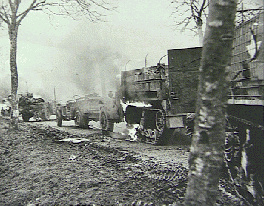
Burning American vehicles blasted by German attack launched in the Ardennes, German counter-offensive in the Ardennes.
-
17 December 1944,
-
Mass murder on American prisoners of war at Malmédy.
The massacre was committed by troops of 1st SS Panzer Division
Leibstandarte Adolf Hitler, Kampfgruppe Peiper.
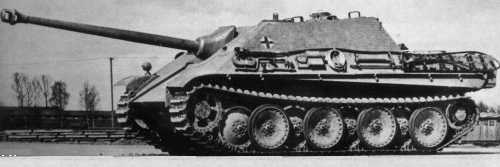
Jagdpanthers were produced in 1944 and 1945. They equipped heavy antitank battalions and served mainly on the Eastern Front, but many were concentrated in the Ardennes Offensive too.
-
17+ 18 December 1944,
-
In the Pacific Task Force 38 (regrouping after recent attacks on Luzon) involved in
a particular bad heavy weather typhoon,
which inflicts worse damage than the Japanese; 3 destroyers sank and 21 ships
(carriers and other destroyers) damaged.
-
22 December 1944,
-
Counter-offensive of General Patton from Arlon into the direction of Bastogne.
Patton, General George (1885-1945)
Patton commanded an armoured corps in 1941 and fought in Tunisia in 1943.
In 1944 his Third Army cut across France in a sweep through Brittany, round Paris, up the Marne and the Moselle, across the
Rhine and into northern Bavaria, entering Czechoslovakia in April 1945.
He was killed in a road accident in occupied Germany in December 1945.
-
25 December 1944,
-
Soviet forces reach Budapest, Hungary.
-
31 December 1944,
-
Operation Nordwind, the second and final phase of the Nazi winter offensive
began.
Women were a vital part of the war effort in the armed services, in various
auxiliary and voluntary services, in the factories, and in keeping life at home
going for husbands and families.



















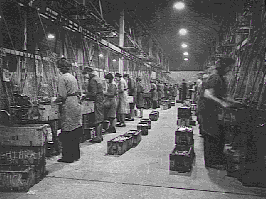
![]()